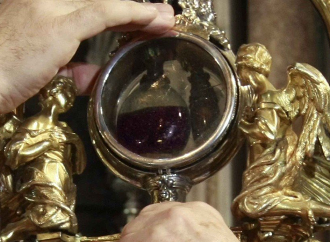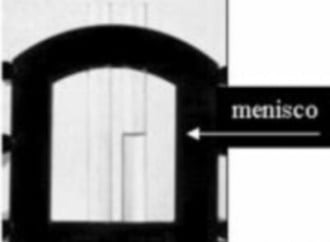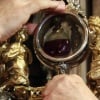Among the religious relics still venerated by the Roman Catholic Church are remains of the blood of early saints. Some of these samples become liquefied from their usual clotted state on specific occasions, generally during religious ceremonies. The most celebrated of these miraculous relics is a vial containing a dark, unknown substance, considered to be the blood of St Januarius, that has been liquefied once or twice a year since 1389 in Naples.[1]
Other relics of this kind, wherein the phase transition is evident and genuine, are the blood of St Pantaleone in Ravello (Avellino) and that of St Lorenzo in Amaseno (Frosinone), whose visual properties and behaviour appear extremely similar. [2]
Some years ago we proposed [3] [4]that thixotropy may furnish an explanation for the properties of the Januarian blood. Thixotropy denotes the property of certains gels to liquefy when stirred or vibrated, and to solidify again when left to stand. The very act of handling the relic during the ceremony, repeatedly turning it upside down to check its state, can provide the necessary shear force to trigger the liquefaction. In support of our hypothesis we also succeeded in preparing thixotropic samples, closely resembling the Januarian relic, using materials and techniques available in the fourteenth century.
Although the Januarian relic is subjected to many mechanical stresses, however, the vial containing the blood of St Pantaleone (becoming liquefied around July 27th ) is never moved, as it is locked behind a grating; and that of St Lorenzo is gently moved only once, on August 10th , from its niche to the altar. In these cases, then, thixotropy cannot be the explanation. Moreover, it appears that the liquefaction begins days before the feast day, and ends much later (precise day-to-day records are lacking).
We have recently had the opportunity to examine the small flask which allegedly contains the blood of St Lorenzo. It consists of a small glass vial, 15 cm high, containing an estimated amount of 35 ml of a mixture of substances. On the bottom there is a lumpy, tan-coloured layer, possibly containing sand or earth. On top of this there is a second layer, normally in the solid state, also brownish, topped by a third, thin, more amorphous layer. When liquefied, the middle layer becomes clear and ruby red, and flows freely if the flask is tilted slightly. The bottom layer always remains solid and the top one sometimes becomes partly liquefied.
When we examined the relic, the middle layer was liquid while the other two layers were still opaque and solid. We whirled the ampoule for 10 sec on a test-tube mixer to check for a possible stress-induced thixotropic phase transition, but the only result was that the two uppermost layers became slightly mixed . The bottom layer remained unchanged, and a further 10-sec whirling failed to alter the fluidity of the viscous contents. We then cooled down the small flask by immersing its lower part into a water-ice bath. After a few minutes, the entire contents solidified into an opaque tan-coloured mass.
Finally, we slowly re-warmed the water bath again to the initial room temperature (29-30 °C) by placing a hair-dryer under it, while monitoring its temperature by a chemistry thermometer. At 29 - 30 °C the contents of the flask melted again, thus clearly demonstrating that the observed change is simply a temperature-related effect of a low-melting compound.
We note that the red substance cannot possibly be blood, since whole blood is typically opaque; even a clear haemoglobin solution would have decomposed and lost its bright red colour over the centuries; and a water solution would have dried up from the imperfectly sealed flask, and would not freeze at 30 ° C.
The softening temperature and the overall look suggest that the relic consists of fats, waxes, or mixtures thereof, containing an appropriate oil-soluble red dye (e. g. "dragon's blood" ). As a matter of fact, this relic is described in the church consecration act scroll (1177) as reliquia de pinguedine St. Laurentii Mart. (relic from the fat of the martyr Saint Lorenzo). The liquefaction phenomenon was not observed until the XVII century, when it became dubbed "fat and blood" and finally just "blood".
A tiny sample, extracted with a syringe through the somewhat loose cork, might easily be analyzed to obtain exact data, but the permission to do so has not, so far, been given by the Church authorities.
Other relics of this kind, wherein the phase transition is evident and genuine, are the blood of St Pantaleone in Ravello (Avellino) and that of St Lorenzo in Amaseno (Frosinone), whose visual properties and behaviour appear extremely similar. [2]
Some years ago we proposed [3] [4]that thixotropy may furnish an explanation for the properties of the Januarian blood. Thixotropy denotes the property of certains gels to liquefy when stirred or vibrated, and to solidify again when left to stand. The very act of handling the relic during the ceremony, repeatedly turning it upside down to check its state, can provide the necessary shear force to trigger the liquefaction. In support of our hypothesis we also succeeded in preparing thixotropic samples, closely resembling the Januarian relic, using materials and techniques available in the fourteenth century.
Although the Januarian relic is subjected to many mechanical stresses, however, the vial containing the blood of St Pantaleone (becoming liquefied around July 27th ) is never moved, as it is locked behind a grating; and that of St Lorenzo is gently moved only once, on August 10th , from its niche to the altar. In these cases, then, thixotropy cannot be the explanation. Moreover, it appears that the liquefaction begins days before the feast day, and ends much later (precise day-to-day records are lacking).
We have recently had the opportunity to examine the small flask which allegedly contains the blood of St Lorenzo. It consists of a small glass vial, 15 cm high, containing an estimated amount of 35 ml of a mixture of substances. On the bottom there is a lumpy, tan-coloured layer, possibly containing sand or earth. On top of this there is a second layer, normally in the solid state, also brownish, topped by a third, thin, more amorphous layer. When liquefied, the middle layer becomes clear and ruby red, and flows freely if the flask is tilted slightly. The bottom layer always remains solid and the top one sometimes becomes partly liquefied.
When we examined the relic, the middle layer was liquid while the other two layers were still opaque and solid. We whirled the ampoule for 10 sec on a test-tube mixer to check for a possible stress-induced thixotropic phase transition, but the only result was that the two uppermost layers became slightly mixed . The bottom layer remained unchanged, and a further 10-sec whirling failed to alter the fluidity of the viscous contents. We then cooled down the small flask by immersing its lower part into a water-ice bath. After a few minutes, the entire contents solidified into an opaque tan-coloured mass.
Finally, we slowly re-warmed the water bath again to the initial room temperature (29-30 °C) by placing a hair-dryer under it, while monitoring its temperature by a chemistry thermometer. At 29 - 30 °C the contents of the flask melted again, thus clearly demonstrating that the observed change is simply a temperature-related effect of a low-melting compound.
We note that the red substance cannot possibly be blood, since whole blood is typically opaque; even a clear haemoglobin solution would have decomposed and lost its bright red colour over the centuries; and a water solution would have dried up from the imperfectly sealed flask, and would not freeze at 30 ° C.
The softening temperature and the overall look suggest that the relic consists of fats, waxes, or mixtures thereof, containing an appropriate oil-soluble red dye (e. g. "dragon's blood" ). As a matter of fact, this relic is described in the church consecration act scroll (1177) as reliquia de pinguedine St. Laurentii Mart. (relic from the fat of the martyr Saint Lorenzo). The liquefaction phenomenon was not observed until the XVII century, when it became dubbed "fat and blood" and finally just "blood".
A tiny sample, extracted with a syringe through the somewhat loose cork, might easily be analyzed to obtain exact data, but the permission to do so has not, so far, been given by the Church authorities.
References
1) G. B. Alfano and A. Amitrano, Il miracolo di S. Gennaro: documentazione storica e scientifica. (Scarpati, Napoli, 1924.)
2) G. B. Alfano and A. Amitrano, Notizie storiche ed osservazioni sulle reliquie di sangue dei martiri e dei santi confessori ed asceti che si conservano in Italia e particolarmente in Napoli. (Arti grafiche Adriana, Napoli, 1951).
3) L. Garlaschelli, F. Ramaccini and S. Della Sala, Nature, 353 507 (1991).
4) L. Garlaschelli, F. Ramaccini and S. Della Sala, Ch. Br. 30, 123 (1994).


















